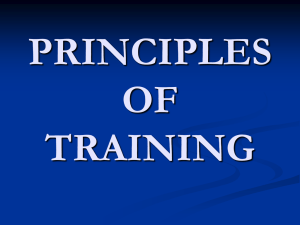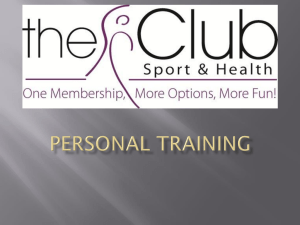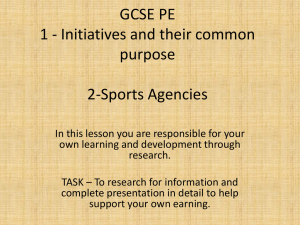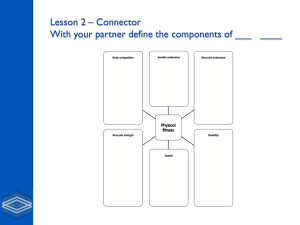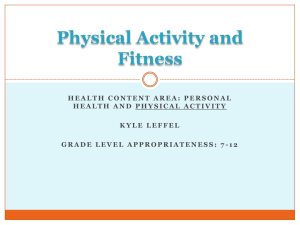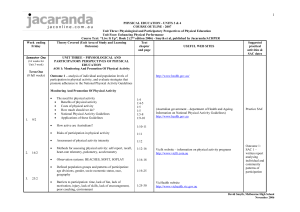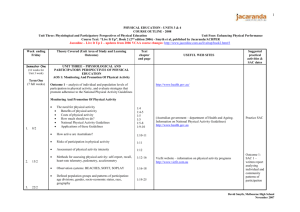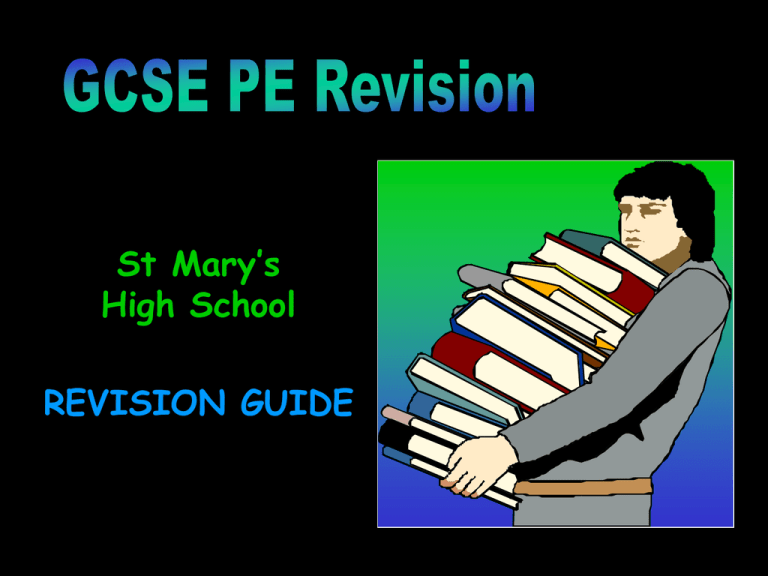
St Mary’s
High School
REVISION GUIDE
What is a HEALTHY, ACTIVE LIFESTYLE?
“A lifestyle that contributes positively to physical, mental and social
wellbeing and includes regular exercise and physical activity”
What are the benefits of taking part in physical activity?
• Social
Meet people,
Make friends.
Co-operation
Competition
Physical challenge
Aesthetic appreciation
• Mental
Relieve stress/tension
Stress-related illness
• Physical
Improve body shape
Good health
6 INFUENCES on your Healthy, Active Lifestyle
Image
Fashion:
Media:
Health
the best boots, clothing and equipment
increases popularity London Marathon, New Year, Wimbledon
Cultural Factors
Disability:
Age:
Gender:
Race:
resources, opportunities, funding
some sports have age-restrictions e.g. minimum 18 for Marathon
Illness
Conditions
People
Family
Peers
Role Models
women’s football taken less seriously then men’s
ethnic background – fewer Asian footballers than other races
Resources
Availability:
Location:
Access:
Time:
if people are willing, facilities need to be provided
local availability e.g. lack of space in inner-city areas
parking, public transport to facilities
availability for demand: school facilities available “after hours”
Good or bad
role model?
Socio-Economic
Cost:
Status:
hire of facilities and equipment e.g. ice-rink, skates
employed (more disposable income), unemployed (need to save money)
OPPORTUNITIES to Become INVOLVED
Where are you?
Physical Education is
not just about being
the best performer in
a sport!
INITIATIVES To Get People Involved
Government:
PESSCL:
‘Club Links’
‘Step Into Sport’
Sport England:
Youth Sport Trust TOPS
Active Kids
At least 2 hours of high quality PE per week
Strengthens links between school and local clubs (ages 5-16)
Opportunity to be performer, leader, official, volunteer
Start (participate), Stay (competition and Succeed (talented can progress)
14-16 – organise festivals in local primaries, sports leadership courses
Supermarkets run voucher programmes to aid purchase of equipment
Key Definitions
Health
Fitness
Exercise
“Health is a state of complete physical, mental and
social well-being and not merely the absence of
disease or infirmity”.
“The ability to meet the demands of the environment”.
“a form of physical activity done primarily to improve
one’s health and physical fitness”
Performance
“How well a task is completed”
Remember you can be fit but not healthy
e.g. Sir Steve Redgrave has diabetes but is a 5-time Olympic champion
•
C.V. fitness:
“the ability to exercise the entire body for long periods of time”.
TEST: 12-min Cooper Run or Bleep Test
•
Muscular Strength:
“The ability to apply force and overcome resistance”.
TEST: Gripometer
•
Muscular Endurance:
“The ability to use muscles, many times without getting tired”.
TEST: Sit-Up Bleep Test
•
Flexibility:
“The range of movement at a joint.”
TEST: Sit and Reach
•
Body composition:
“The percentage of body weight which is fat muscle and bone.”
TEST: BMI
6 Skill-Related Fitness
Components (BCRAPS)
•
Balance
retain centre of mass over base of support
TEST:
•
Illinois Agility Run
Power
ability to do strength movements quickly: strength x speed
TEST:
•
Ruler Drop
Agility
ability to change direction at speed
TEST:
•
Tennis Ball Throw
Reaction Time
time between the presentation of a stimulus and onset of movement
TEST:
•
Stork Balance Test
Co-ordination
to use two or more body parts together
TEST:
•
Remember you need to fill in a Physical
Activity Readiness Questionnaire (PARQ)
prior to taking part in activity to assess the
level of risk and use the right protocols to
perform safely.
Standing Broad Jump (Long Jump)
Speed
how fast your body can move over a short distance
TEST:
30m Sprint
Principles of Training
•
Individual Needs “matching training to the requirements of the individual”
e.g. struggle to complete game therefore CV fitness
•
Specificity: “matching training to the requirements of the activity”
e.g. goalkeepers training for agility, midfielders for cardiovascular fitness
•
Progressive Overload: “gradually increasing he amount of overload so as
to gain fitness without the risk of injury”.
•
•
Rest:
Recovery:
•
Reversibility: “any adaptation from training is reversed during inactivity”
“The period of time allotted to recovery”
“The time required to repair damage caused by training”
F.I.T.T Principle
Overload is applied to a training programme by using the FITT principle.
Increase the…
Increase the…
Increase the…
Choose correct…
e.g.
Frequency
Intensity
Time
Type of exercise
how often
how hard
how long
method of training
someone wanting to improve their CV Endurance
Frequency 3 times per week
Intensity
60-80% of maximum HR
Time
30 minutes per session
Type
Method e.g. continuous running
Goal Setting
People who set sensible goals are able to
focus their energies on their training and achieve them.
Specific
Measurable
Achievable
Realistic
Time-bound
e.g. I want to run half a lap further in the 12-min run
e.g. running half a lap further – easy to measure!
e.g. training plan to build on CV fitness – half lap achieved!
e.g. running half a lap is more realistic than 4 extra laps
e.g. 6 week training programme – put a clear end point in
This are the first steps towards designing your
Personal Exercise Programme (PEP)
Training Methods
Each is designed for a specific purpose, to improve a specific aspect of fitness
- combination of METHODS develop sporting performance (CROSS TRAINING)
CONTINUOUS
Defined as:
Sports:
Advantages:
“high duration, low intensity exercise without rest periods”
e.g. (30 mins jogging)
e.g. cycling, swimming, team sports in pre-season to build aerobic base
Cheap, wide range of activities available, can apply FITT to suit needs
INTERVAL
Defined as:
Sports:
Advantages:
“high intensity periods of work followed by defined periods of rest”
e.g. (sprint 60m, 30s rest)x6, 5-min rest then perform set again - SPEED
e.g. (15 mins jogging, 3 minutes rest) x4 – CARDIOVASCULAR FITNESS
e.g. Swimming, Athletics, Football
improves speed and CV fitness, high intensity, works high HR zones
SPRINT 30s rest
SPRINT30s rest
CIRCUIT
Sports:
Advantages:
“A number of exercises arranged to avoid training the same muscle groups”
e.g. (6-10 stations can work muscles and CV system, also skills in your sport)
e.g. work for set time (1 min), set reps (30 reps), rest for 2 mins at end of 1 circuit
e.g. football, cricket, tennis, badminton
work (strength, speed, CV, muscular endurance in 1 session), aerobic/anaerobic
FARTLEK
Swedish for ‘Speed Play’
Defined as:
Sports:
Advantages:
“A combination of fast and slow running”
e.g. rugby, football, netball – those with changes in speed throughout
can include hill work and different terrains, flexible to suit individual sport/needs
Defined as:
WEIGHT
Defined as:
Sports:
Advantages:
“a common type of training to develop strength and size of skeletal muscles”
e.g. speed, strength, power sports (long jump, javelin, football, rugby)
can improve musc. strength, musc. endurance, power, easy to overload, variety
JOG---SPRINT--75%---JOG
Exercise Session
•
Warm up:
Pulse raisers, stretches, mobilising joints
PREVENTS INJURY, IMPROVES PERF.
•
Main activity:
Skills, drills, tactics
WORKS SPECIFIC GOALS/COMPONENTS
•
Cool down:
PREPARES FOR FUTURE SESSIONS
To remove lactic acid and repay oxygen debt.
Target Heart Rate Zones
•
Heart rate = “number of times the heart beats per min”
•
•
Maximum heart rate = (220 – age)
Training/ target zones are calculated using this equation
•
Less than 60% MHR = Recovery zone (cool down)
•
60 – 80% MHR = Aerobic training zone
•
80 - 90% MHR = Anaerobic training zone
•
90 – 95% MHR = Speed training zone.
Anaerobic Exercise
•
•
Without O2 (Oxygen)
Very short period of time 1-10 seconds
How would you improve your ability
to work anaerobically?
•
•
Work very, very hard in short bursts
Be around 85% of your maximum heart rate
(220 - age = 100%)
GLUCOSE =
ENERGY
+
LACTIC ACID
Aerobic Exercise
•
•
Exercise with (using) O2
Over a long period of time
How would you improve your ability to work aerobically?
•
•
•
Work hard and for a long time (at least 20 minutes in training zone)
Work between 60% and 80% of the maximum heart rate
(for a 14 year old that is between approx 125-170bpm)
Use large muscle groups
GLUCOSE + OXYGEN =
CO2 + WATER + ENERGY
Diet and Nutrition
•
•
•
•
•
•
•
Most
Valuable
Player
Football
Club
F
W
–
–
–
–
–
–
–
Dietary Intake and Performance
Minerals
Vitamins
Protein
Fat
Carbohydrates
Fibre
Water
Ensure you know why calcium and Iron are needed
Minerals
Vitamins
Protein
Fat
Carbohydrates
Fibre
Water
–
–
–
–
–
–
–
Calcium
Iron
‘C’
Meat
Cheese
Bread
Cereal
Carbo-Loading
A system mainly used by marathon runners
e.g. Marathon 1 week today (Sunday)
Protein-rich foods (Mon-Tues) – depletes carb stores
Carb-rich foods (Weds-Sat) – fully replenishes stores
Body is fooled into storing more carbs due to starvation process
The protein is needed to repair muscle, carbs to fuel the activity.
It is important to take food within the 2 hours after a race/activity to
replenish lost stores.
Blood-Flow During Exercise
Blood is shunted from other areas of the body (particularly organs)
to the working muscle during exercise.
Less blood is available to digest food in the gut – can cause
cramp.
Exercise should ideally not start until 2-3 hours after the meal.
–
–
–
–
–
–
–
–
Strong teeth and bones
Help the blood to carry O2
To prevent scurvy
Growth and repair
Slow energy
Fast energy
Helps digestion
Needs to be replaced
Extreme Body Types (Somatotypes)
• Endomorph – lots of fat
• Mesomorph – lots of muscle
• Ectomorph - skinny
•
Overweight
Having weight in excess of normal. Not harmful unless accompanied by over-fatness
•
Over-fat
Having body fat in excess of normal
•
Obese
Describes people who are very over-fat
•
Anorexia
A prolonged eating disorder due to the loss of appetite
•
Optimum Weight
Best weight or desirable weight – the best weight a player performs at
***(Potential 6 mark question for you to discuss)***
Factors Affecting Optimum Weight
•
Height – taller people often (not always) heavier
•
Gender – Men/women have different body composition
•
Bone Structure – ‘Frame’ of skeleton depends on bone structure e.g. broad shoulders/thick wrists
compared to narrow shoulders/hips
•
Muscle Girth – increases with training, larger muscle weighs more so sportspeople need to look at
the appropriate charts
•
Genetics – body weight and shape are largely passed on by parents
OPTIMUM WEIGHT IN SPORT
Needs to be compared to similar with sports, positions and events e.g. between forwards in rugby,
jockeys in horse racing and footballers. The rules of a sport can often govern what an optimum
weight is (boxing weights for example)
Beta Blockers
Drugs that are used to control the heart rate
and have a calming/relaxing effect.
• Prescribed to those with heart problems to
maintain low heart rate and blood pressure
• Stress and anxiety levels reduced
• Improves steadiness of hand and precision
• Aids performance in archery, snooker, skijumping, gymnastics
Side effects:
Reduces heart rate to dangerously lo levels,
nausea, depression, insomnia, nightmares
Anabolic Steroids
Stimulants
Drugs that have an effect on the central
nervous system, such as increased mental
and / or physical awareness.
• Amphetamines, Cocaine, Ephedrine
• Help to overcome tiredness
• Offset the effects of lactic acid
Side effects:
Insomnia, irritability, irregular heart beat, high
blood pressure, addiction
Peptide Hormones
Narcotics/Analgesics
Drugs that can be used to reduce and /
or mask pain.
• Heroin, methadone, morphine
• Can return to competition quicker
• Increase risk of long-term injury
Side effects:
Loss of: concentration, balance,
ordination, bring on hallucinations
co-
Diuretics
Drugs that cause other hormones to be
produced.
Drugs that elevate the rate of urine
production.
• Misused by boxers & jockeys who need to
lose weight to make the correct weight.
• Increase strength and allow you to train harder
and recover faster
• Produce results quicker
• Increase aggression
• Human Growth Hormone (HGH), EPO used
for anaemia but increases RBC so improved
aerobic capacity
• Increase muscle growth
• Assist recovery
• Increase red blood cells (RBC)
Side effects:
Increased risk of heart attack/stroke, high blood
pressure, liver disease, infertility, death
Side effects:
Thickens blood, causes dehydration, increased
risk of heart attack/stroke
Drugs that mimic the male sex hormone
testosterone and promote bone/muscle
growth.
Side effects:
Dehydration – dizziness, muscle cramps,
headaches and nausea, also kidney disease
Recreational Drugs
Nicotine
Cigarettes. Nicotine, tar and carbon monoxide. Affects
sports performance by getting less oxygen to working
muscles so aerobic fitness is decreased. Improves
alertness but extremely addictive.
Alcohol
Affects co-ordination, balance, reaction time. Acts as a
SEDATIVE, slowing reactions and impairing judgement.
Increases dehydration
Socially Acceptable Drugs
Socially Unacceptable Drugs
Drugs prescribed over the counter by a doctor such
as paracetamol and aspirin to treat medical
conditions
Illegal and unacceptable to most people e.g. heroin,
cocaine, LSD. All have negative effects and can
lead to death.
Risk Assessment and Prevention of Injury
Warming Up / Cooling Down
Checking Equipment and Facilities
WU – warm the muscles gradually to prevent injury
CD – prevents injury and disperses lactic acid preventing soreness and aches
•
•
•
Protective Equipment and Clothing
•
•
•
Football, Hockey, Sailing.
Remove jewellery, ensure your equipment isn’t a danger to others.
Footwear – appropriate to activity e.g. length of studs, supportive for the
ankles, comfortable.
Balanced Competition
•
Weight Categories
Weightlifting, Boxing
•
Mixed/Single sex
Contact sports split e.g. rugby, football
Athletics – split on fair competition grounds
Hockey/Racquet sports – mixed and open comp
•
Age
Children split in age group
Seniors/Veterans in golf, marathon, tennis
•
Handicap System
Golf to allow those of mixed ability to play together
Are they safe and secure?
In good condition?
Check pitch-side for debris, are the markings clear?
Rules
Ensure safety and help the game flow
Ensure fairness and give the game structure.
When broken, participants are punished by bans/fines
Physical Readiness
Completing a physical activity readiness questionnaire is important
to ensure all those participating are safe and healthy to do so. It
highlights beforehand any potential issues.
Example Question
All sporting activities have clearly
stated rules. State three reasons why
we have rules in sport. (3)
Keep Checking…..
Check www.mrt10.wordpress.com weekly for
the additions to the body systems from your
Y11 course!
REMEMBER !!!
As soon as the exam starts write these key points down
• Mental, Social, Physical benefits
• HRF –
Body Comp, CV, Musc.Endurance, Flexibility, Musc.Strength
(FBMMC)
• SRF –
Balance, Co-ord, Reaction time, Agility, Power, Speed.
(BCRAPS)
• SPORRI -
Specificity, Progressive Overload, Rest and Recovery,
Individual Needs
• Frequency, Intensity, Time, Type. (FITT)


